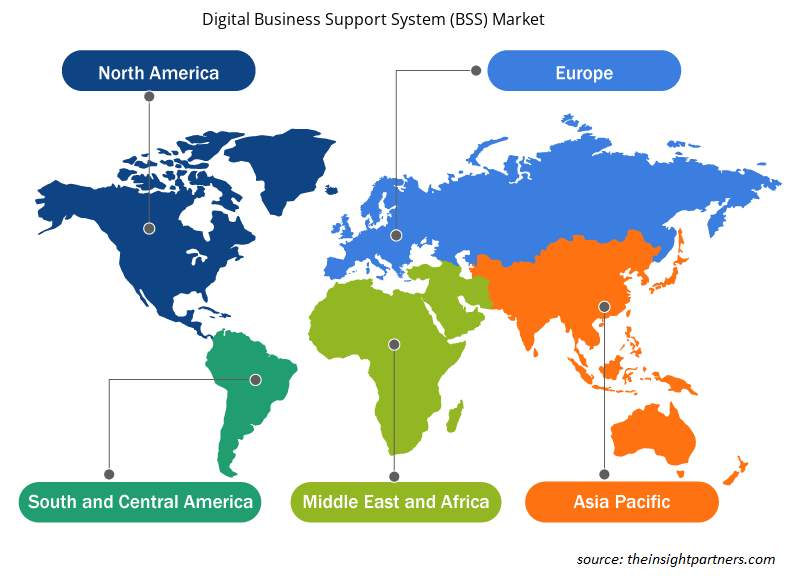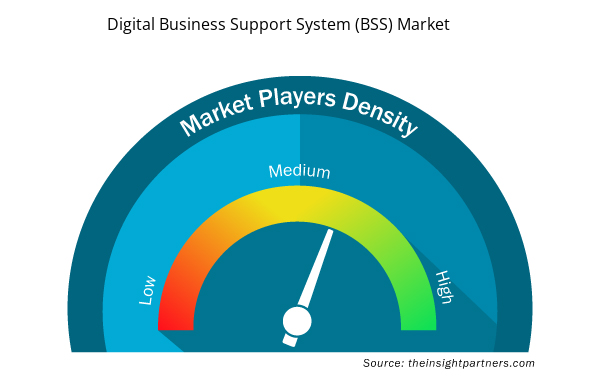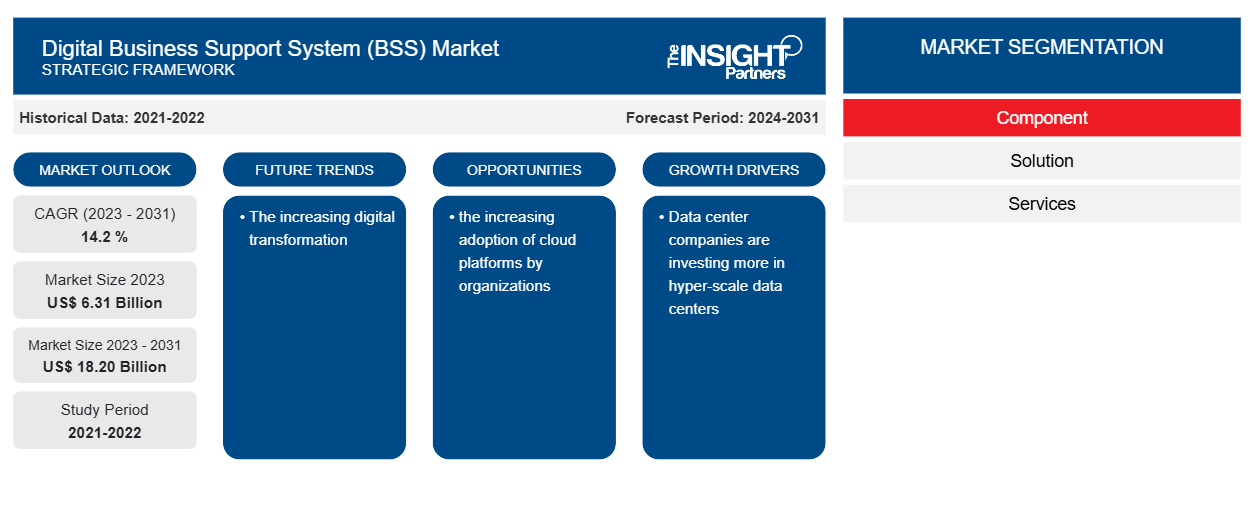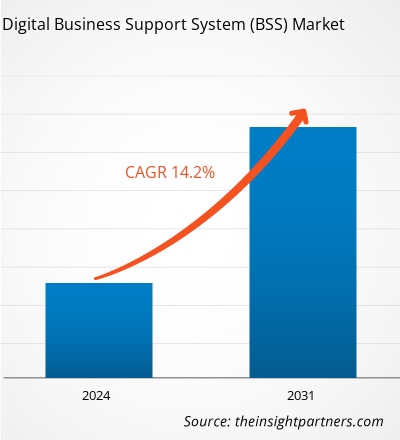Si prevede che la dimensione del mercato del Digital Business Support System (BSS) raggiungerà i 18,20 miliardi di dollari entro il 2031, rispetto ai 6,31 miliardi di dollari del 2023. Si prevede che il mercato registrerà un CAGR del 14,2% nel 2023-2031.ILÈ probabile che la crescente trasformazione digitale rimanga una tendenza chiave del mercato dei sistemi di supporto aziendale digitale (BSS).
Analisi di mercato del sistema di supporto alle imprese digitali (BSS)
Il mercato dei sistemi di supporto aziendale digitale sta crescendo rapidamente a causa di una serie di fattori, tra cui la crescente adozione di soluzioni BSS personalizzate e nuovi modelli commerciali, l'aumento della riduzione dei costi operativi, l'incremento delle transazioni online e l'uso di più dispositivi mobili, la crescente assunzione di soluzioni BSS basate su cloud, la crescente tendenza alla digitalizzazione nel settore delle telecomunicazioni e la crescente adozione di sistemi di supporto aziendale digitale da parte dei produttori al fine di aggiungere valore all'azienda massimizzando il ritorno sull'investimento, fornendo un servizio clienti superiore, riducendo i costi e accelerando il time-to-market per nuovi prodotti e servizi.
Panoramica del mercato dei sistemi di supporto alle imprese digitali (BSS)
Un sistema di supporto aziendale digitale è un tipo di piattaforma o soluzione che offre alle aziende commerciali vantaggi operativi e monitoraggio. L'accettazione degli ordini, le richieste relative ai pagamenti e la gestione dei ricavi dei clienti sono tutti parte del sistema di supporto aziendale. Oltre a offrire numerosi strumenti aggiuntivi di gestione delle operazioni, il sistema fornisce alle aziende approfondimenti sul marketing e sulle operazioni aziendali, che consentono loro di prendere decisioni consapevoli sui lanci di prodotti e sulle spese di marketing .
Personalizza questo report in base alle tue esigenze
Riceverai la personalizzazione gratuita di qualsiasi report, comprese parti di questo report, o analisi a livello nazionale, pacchetto dati Excel, oltre a usufruire di grandi offerte e sconti per start-up e università
- Scopri le principali tendenze di mercato in questo rapporto.Questo campione GRATUITO includerà analisi di dati che spaziano dalle tendenze di mercato alle stime e alle previsioni.
Driver e opportunità di mercato del sistema di supporto alle imprese digitali (BSS)
Le aziende di data center stanno investendo sempre di più in data center di grandi dimensioni.
Numerose aziende di data center hanno effettuato investimenti significativi in data center iper-scala, che si prevede produrranno prospettive di espansione redditizie. Equinix ha rivelato l'intenzione di costruire circa 32 data center iper-scala in alcuni importanti mercati europei lo scorso anno. Investendo più di 6,9 miliardi di USD e avendo una capacità totale di oltre 600 megawatt, la società spera di migliorare la propria posizione nel mercato dei data center iper-scala in rapido sviluppo. La domanda per il mercato HCI nella regione aumenterà come risultato di questa espansione dei data center nell'area.Equinix revealed intentions to build about 32 hyper-scale data centers in a few significant European markets last year. Investing more than USD 6.9 billion and having a total capacity of over 600 megawatts, the company hopes to improve its standing in the rapidly developing hyper-scale data center market. The demand for the HCI market in the region will rise as a result of this expansion of the data centers in the area.
La crescente adozione di piattaforme cloud da parte delle organizzazioni
Si prevede che la crescente adozione di piattaforme cloud da parte delle organizzazioni, in particolare nelle nazioni emergenti, stimolerà la crescita del mercato Digital Business Support System nell'area Asia-Pacifico. Ad esempio, si prevede che l'adozione di carichi di lavoro cloud ibridi in India triplicherà dal 13% al 43%, secondo il Nutanix Cloud Index. La società si sta concentrando maggiormente sull'espansione aziendale e sullo sviluppo di nuovi prodotti come risultato del crescente utilizzo di tecnologie digitali per il coinvolgimento dei consumatori. Pertanto, si prevede che la crescente necessità di accuratezza e gestione dei dati presenterà nuove opportunità per gli operatori del mercato Digital Business Support System (BSS) durante il periodo di previsione.Nutanix Cloud Index. The corporation is focusing more on business expansion and new product development as a result of the increased use of digital technologies for consumer engagement. Thus, the increasing need for data accuracy and data management is anticipated to present new opportunities for the Digital Business Support System (BSS) Market players during the forecast period.
Analisi della segmentazione del rapporto di mercato del sistema di supporto alle imprese digitali (BSS)BSS) Market Report Segmentation Analysis
I segmenti chiave che hanno contribuito alla derivazione dell'analisi di mercato del Digital Business Support System (BSS) sono i componenti.BSS) Market analysis are components.
- In base al componente, il mercato Digital Business Support System (BSS) è segmentato in soluzioni e servizi. Il segmento dei servizi ha detenuto una quota di mercato maggiore nel 2023.BSS) Market is segmented into solutions and services. The services segment held a larger market share in 2023.
Analisi della quota di mercato del sistema di supporto alle imprese digitali (BSS) per area geograficaBSS) Market Share Analysis by Geography
L'ambito geografico del rapporto di mercato Digital Business Support System (BSS) è principalmente suddiviso in cinque regioni: Nord America, Asia Pacifico, Europa, Medio Oriente e Africa e Sud America/Sud e Centro America. In termini di fatturato, il Nord America ha rappresentato la quota di mercato più grande del Digital Business Support System (BSS). Rispetto ad altre regioni, il Nord America sta assistendo a una crescita più rapida nella cultura delle startup. L'emergere delle PMI e la crescente digitalizzazione del settore delle telecomunicazioni hanno contribuito all'espansione del mercato BSS digitale in Nord America. La crescente accessibilità delle soluzioni basate su cloud è un altro fattore che spinge l'adozione di soluzioni BSS digitali nella regione. Rispetto alle soluzioni on-premise convenzionali, le soluzioni BSS basate su cloud presentano una serie di vantaggi, come costi iniziali inferiori, maggiore sicurezza e scalabilità flessibile. Questi elementi contribuiranno probabilmente alla continua crescita del Nord America nell'adozione di soluzioni BSS digitali nei prossimi anni.
Approfondimenti regionali sul mercato del sistema di supporto alle imprese digitali (BSS)
Le tendenze regionali e i fattori che influenzano il mercato del Digital Business Support System (BSS) durante il periodo di previsione sono stati ampiamente spiegati dagli analisti di Insight Partners. Questa sezione discute anche i segmenti di mercato del Digital Business Support System (BSS) e la geografia in Nord America, Europa, Asia Pacifico, Medio Oriente e Africa e Sud e Centro America.

- Ottieni i dati specifici regionali per il mercato del sistema di supporto alle imprese digitali (BSS)
Ambito del rapporto di mercato del sistema di supporto aziendale digitale (BSS)
| Attributo del report | Dettagli |
|---|---|
| Dimensioni del mercato nel 2023 | 6,31 miliardi di dollari USA |
| Dimensioni del mercato entro il 2031 | 18,20 miliardi di dollari USA |
| CAGR globale (2023-2031) | 14,2% |
| Dati storici | 2021-2022 |
| Periodo di previsione | 2024-2031 |
| Segmenti coperti | Per componente
|
| Regioni e Paesi coperti | America del Nord
|
| Leader di mercato e profili aziendali chiave |
|
Densità degli attori del mercato del Digital Business Support System (BSS): comprendere il suo impatto sulle dinamiche aziendali
Il mercato del Digital Business Support System (BSS) sta crescendo rapidamente, spinto dalla crescente domanda degli utenti finali dovuta a fattori quali l'evoluzione delle preferenze dei consumatori, i progressi tecnologici e una maggiore consapevolezza dei vantaggi del prodotto. Con l'aumento della domanda, le aziende stanno ampliando le loro offerte, innovando per soddisfare le esigenze dei consumatori e capitalizzando sulle tendenze emergenti, il che alimenta ulteriormente la crescita del mercato.
La densità degli operatori di mercato si riferisce alla distribuzione di aziende o società che operano in un particolare mercato o settore. Indica quanti concorrenti (operatori di mercato) sono presenti in un dato spazio di mercato in relazione alle sue dimensioni o al valore di mercato totale.
Le principali aziende che operano nel mercato dei sistemi di supporto aziendale digitale (BSS) sono:
- Amdocs limitata
- Società controllata da Huawei
- Telefonaktiebolaget LM Ericsson
- Società di tecnologia NetCracker
- CSG Systems International, Inc.
- Optiva Inc.
Disclaimer : le aziende elencate sopra non sono classificate secondo un ordine particolare.

- Ottieni la panoramica dei principali attori del mercato dei sistemi di supporto alle imprese digitali (BSS)
Notizie di mercato e sviluppi recenti del sistema di supporto alle imprese digitali (BSS)
Il mercato del Digital Business Support System (BSS) viene valutato raccogliendo dati qualitativi e quantitativi dopo la ricerca primaria e secondaria, che include importanti pubblicazioni aziendali, dati associativi e database. Di seguito è riportato un elenco degli sviluppi nel mercato dei disturbi e delle strategie del linguaggio e della parola:
- Nel giugno 2023, IBM e Vista Equity Partners hanno firmato un accordo definitivo per l'acquisizione di Apptio Inc. da parte di IBM. Le capacità di automazione IT di IBM cresceranno più rapidamente a seguito dell'acquisizione di Apptio, offrendo ai dirigenti aziendali la possibilità di massimizzare il ritorno sui propri investimenti IT.
(Fonte: IBM, Comunicato stampa)
- Nel luglio 2022, Ericsson ha acquistato Vonage, portando avanti il piano dell'azienda di sfruttare la propria posizione di leader nella tecnologia per potenziare il business della rete mobile e penetrare nel mercato aziendale.
(Fonte: Ericsson, Comunicato Stampa)
Copertura e risultati del rapporto di mercato sul sistema di supporto alle imprese digitali (BSS)
Il rapporto "Dimensioni e previsioni del mercato del sistema di supporto aziendale digitale (BSS) (2021-2031)" fornisce un'analisi dettagliata del mercato che copre le seguenti aree:
- Dimensioni e previsioni del mercato a livello globale, regionale e nazionale per tutti i segmenti di mercato chiave coperti dall'ambito
- Dinamiche di mercato come fattori trainanti, vincoli e opportunità chiave
- Principali tendenze future
- Analisi dettagliata delle cinque forze PEST/Porter e SWOT
- Analisi di mercato globale e regionale che copre le principali tendenze di mercato, i principali attori, le normative e gli sviluppi recenti del mercato
- Analisi del panorama industriale e della concorrenza che copre la concentrazione del mercato, l'analisi della mappa di calore, i principali attori e gli sviluppi recenti
- Profili aziendali dettagliati
- Analisi storica (2 anni), anno base, previsione (7 anni) con CAGR
- Analisi PEST e SWOT
- Valore/volume delle dimensioni del mercato - Globale, regionale, nazionale
- Industria e panorama competitivo
- Set di dati Excel



Report Coverage
Revenue forecast, Company Analysis, Industry landscape, Growth factors, and Trends

Segment Covered
This text is related
to segments covered.

Regional Scope
North America, Europe, Asia Pacific, Middle East & Africa, South & Central America

Country Scope
This text is related
to country scope.
Domande frequenti
The global Digital Business Support System (BSS) Market is expected to reach US$ 18.20 billion by 2031.
The key players holding majority shares in the global Digital Business Support System (BSS) Market are Optiva Inc., Nokia Corporation, Capgemini SE, ZTE Corporation, Openet, and Sigma Software.
The increasing digital transformation is anticipated to play a significant role in the global Digital Business Support System (BSS) Market in the coming years.
The data center companies are investing more in hyper-scale data centers and the increasing adoption of cloud platforms by organizations are the major factors that propel the global Digital Business Support System (BSS) market.
The global Digital Business Support System (BSS) Market was estimated to be US$ 6.31 billion in 2023 and is expected to grow at a CAGR of 14.2 % during the forecast period 2023 - 2031.
Trends and growth analysis reports related to Technology, Media and Telecommunications : READ MORE..
The Insight Partners performs research in 4 major stages: Data Collection & Secondary Research, Primary Research, Data Analysis and Data Triangulation & Final Review.
- Data Collection and Secondary Research:
As a market research and consulting firm operating from a decade, we have published and advised several client across the globe. First step for any study will start with an assessment of currently available data and insights from existing reports. Further, historical and current market information is collected from Investor Presentations, Annual Reports, SEC Filings, etc., and other information related to company’s performance and market positioning are gathered from Paid Databases (Factiva, Hoovers, and Reuters) and various other publications available in public domain.
Several associations trade associates, technical forums, institutes, societies and organization are accessed to gain technical as well as market related insights through their publications such as research papers, blogs and press releases related to the studies are referred to get cues about the market. Further, white papers, journals, magazines, and other news articles published in last 3 years are scrutinized and analyzed to understand the current market trends.
- Primary Research:
The primarily interview analysis comprise of data obtained from industry participants interview and answers to survey questions gathered by in-house primary team.
For primary research, interviews are conducted with industry experts/CEOs/Marketing Managers/VPs/Subject Matter Experts from both demand and supply side to get a 360-degree view of the market. The primary team conducts several interviews based on the complexity of the markets to understand the various market trends and dynamics which makes research more credible and precise.
A typical research interview fulfils the following functions:
- Provides first-hand information on the market size, market trends, growth trends, competitive landscape, and outlook
- Validates and strengthens in-house secondary research findings
- Develops the analysis team’s expertise and market understanding
Primary research involves email interactions and telephone interviews for each market, category, segment, and sub-segment across geographies. The participants who typically take part in such a process include, but are not limited to:
- Industry participants: VPs, business development managers, market intelligence managers and national sales managers
- Outside experts: Valuation experts, research analysts and key opinion leaders specializing in the electronics and semiconductor industry.
Below is the breakup of our primary respondents by company, designation, and region:

Once we receive the confirmation from primary research sources or primary respondents, we finalize the base year market estimation and forecast the data as per the macroeconomic and microeconomic factors assessed during data collection.
- Data Analysis:
Once data is validated through both secondary as well as primary respondents, we finalize the market estimations by hypothesis formulation and factor analysis at regional and country level.
- Macro-Economic Factor Analysis:
We analyse macroeconomic indicators such the gross domestic product (GDP), increase in the demand for goods and services across industries, technological advancement, regional economic growth, governmental policies, the influence of COVID-19, PEST analysis, and other aspects. This analysis aids in setting benchmarks for various nations/regions and approximating market splits. Additionally, the general trend of the aforementioned components aid in determining the market's development possibilities.
- Country Level Data:
Various factors that are especially aligned to the country are taken into account to determine the market size for a certain area and country, including the presence of vendors, such as headquarters and offices, the country's GDP, demand patterns, and industry growth. To comprehend the market dynamics for the nation, a number of growth variables, inhibitors, application areas, and current market trends are researched. The aforementioned elements aid in determining the country's overall market's growth potential.
- Company Profile:
The “Table of Contents” is formulated by listing and analyzing more than 25 - 30 companies operating in the market ecosystem across geographies. However, we profile only 10 companies as a standard practice in our syndicate reports. These 10 companies comprise leading, emerging, and regional players. Nonetheless, our analysis is not restricted to the 10 listed companies, we also analyze other companies present in the market to develop a holistic view and understand the prevailing trends. The “Company Profiles” section in the report covers key facts, business description, products & services, financial information, SWOT analysis, and key developments. The financial information presented is extracted from the annual reports and official documents of the publicly listed companies. Upon collecting the information for the sections of respective companies, we verify them via various primary sources and then compile the data in respective company profiles. The company level information helps us in deriving the base number as well as in forecasting the market size.
- Developing Base Number:
Aggregation of sales statistics (2020-2022) and macro-economic factor, and other secondary and primary research insights are utilized to arrive at base number and related market shares for 2022. The data gaps are identified in this step and relevant market data is analyzed, collected from paid primary interviews or databases. On finalizing the base year market size, forecasts are developed on the basis of macro-economic, industry and market growth factors and company level analysis.
- Data Triangulation and Final Review:
The market findings and base year market size calculations are validated from supply as well as demand side. Demand side validations are based on macro-economic factor analysis and benchmarks for respective regions and countries. In case of supply side validations, revenues of major companies are estimated (in case not available) based on industry benchmark, approximate number of employees, product portfolio, and primary interviews revenues are gathered. Further revenue from target product/service segment is assessed to avoid overshooting of market statistics. In case of heavy deviations between supply and demand side values, all thes steps are repeated to achieve synchronization.
We follow an iterative model, wherein we share our research findings with Subject Matter Experts (SME’s) and Key Opinion Leaders (KOLs) until consensus view of the market is not formulated – this model negates any drastic deviation in the opinions of experts. Only validated and universally acceptable research findings are quoted in our reports.
We have important check points that we use to validate our research findings – which we call – data triangulation, where we validate the information, we generate from secondary sources with primary interviews and then we re-validate with our internal data bases and Subject matter experts. This comprehensive model enables us to deliver high quality, reliable data in shortest possible time.


 Ottieni un campione gratuito per questo repot
Ottieni un campione gratuito per questo repot